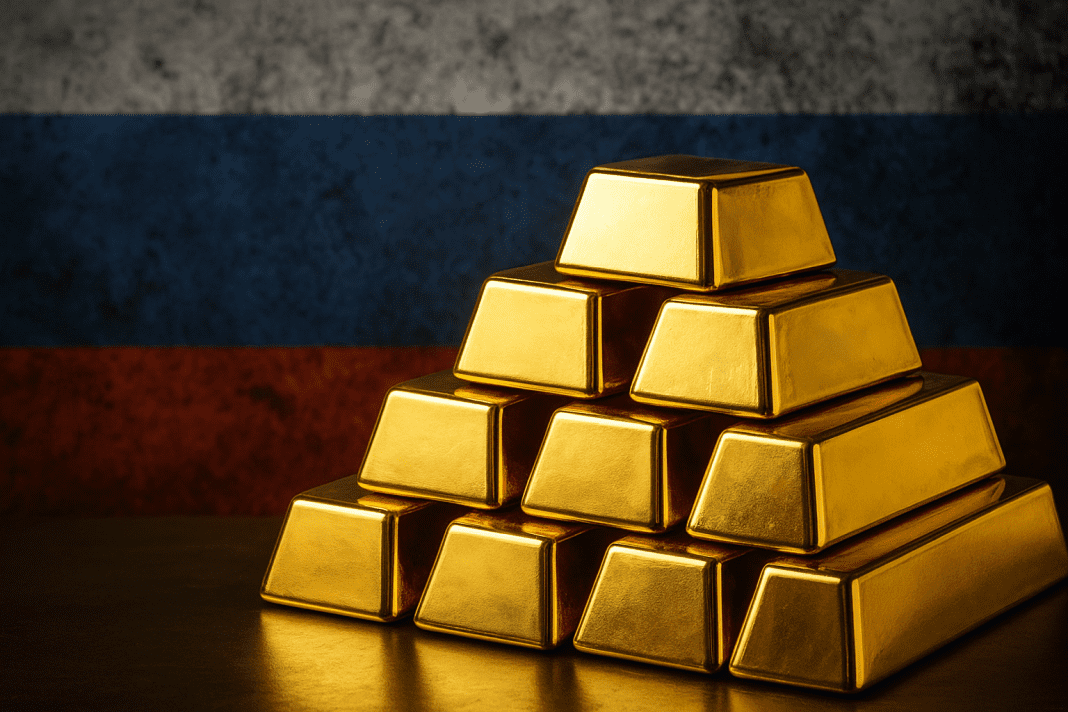In a historic and unprecedented move, Russia has begun selling physical gold from its National Wealth Fund for the first time ever, according to the Central Bank of Russia.
From Paper to Physical Sales: A New Chapter in Russia’s Fiscal Strategy
The decision marks a stark shift from years of accounting maneuvers, revealing the Kremlin’s growing reliance on tangible reserves to sustain government spending amid the ongoing war in Ukraine. Analysts warn that the move signals serious stress in Russia’s wartime economy, highlighting how far Moscow is willing to go to fund its military ambitions.
Until recently, Russia’s gold operations were largely symbolic. The Ministry of Finance would “sell” bullion to the Central Bank, but the metal itself never left the national reserves. It was a paper transaction, allowing Moscow to report liquidity without actually depleting its gold stockpiles. Now, for the first time, the Central Bank is executing real sales on the domestic market — a step experts say is unprecedented in modern Russian history.
The bank confirmed that it is “mirroring” the Finance Ministry’s transactions within the National Wealth Fund, executing real trades similar to those the government already conducts with yuan assets. The exact volume of bullion released has not been disclosed, but estimates suggest the Kremlin has already begun tapping hundreds of tons to shore up its budget.
Gold Reserves Plunge: From 405 Tons to 173
Before the full-scale invasion of Ukraine, the National Wealth Fund held 405.7 metric tons of gold, making it a robust buffer against economic shocks. Since the onset of war, approximately 57% of that stockpile — around 232.6 tons — has been liquidated, leaving just 173.1 tons in reserves as of November 1, 2025. Combined liquid assets, including yuan holdings, have plummeted from $113.5 billion to $51.6 billion, a near fourfold shrinkage relative to GDP.
Economists say the shift to physical bullion sales serves multiple purposes. Not only does it inject cash into the domestic economy, but it also stabilizes the ruble amid continued sanctions and economic pressure. Vladimir Chernov, an analyst at Freedom Finance Global, explains that similar “mirror” operations with yuan assets have contributed roughly $30 billion to the economy this year, with another $15 billion projected for 2026.
The True Cost of War: Oil, Sanctions, and Gold
Russia’s dependence on gold sales underscores a broader fiscal crisis. Federal revenues from oil and gas — historically the backbone of Moscow’s budget — have collapsed by 27% year-over-year, driven by lower global crude prices, tighter sanctions, and a stronger ruble. With the war against Ukraine consuming vast resources, the Kremlin is increasingly forced to rely on sovereign wealth buffers once considered untouchable.
Despite these measures, Russia still maintains over 2,300 tons of gold in total national reserves, ranking fifth globally. Yet the aggressive liquidation of the National Wealth Fund’s gold highlights the strain of sustaining both military campaigns and domestic spending simultaneously. Analysts warn that continued gold sales could erode investor confidence and weaken Russia’s economic resilience in the medium term.
Maria Ivanova, a senior economist at the Moscow Economic Institute, says, “The decision to sell physical gold indicates a serious liquidity crunch. Gold is normally the last line of defense for any sovereign government. Turning it into cash now suggests the Kremlin is prioritizing immediate military and budgetary needs over long-term stability.”
Other experts point to the symbolic impact of selling gold. Historically, Russia has used its bullion stockpiles as both a shield against sanctions and a statement of economic strength. “Physically moving gold out of the fund sends a signal of vulnerability to both domestic and international markets,” says Aleksei Petrov, a geopolitical analyst in St. Petersburg.
The Broader Geopolitical Picture
The timing of Russia’s gold sales also coincides with escalating tensions in Ukraine, ongoing military operations, and tightening sanctions from Western allies. Analysts suggest that Moscow may be preparing for prolonged conflict, needing immediate liquidity to fund weapons, logistics, and troop deployments.
Russia’s physical gold sales are also likely to catch global attention, potentially impacting commodity markets. While the Central Bank has not indicated the total volume being released, even small increments of high-quality gold entering the market can influence prices and trading strategies worldwide.
From a broader perspective, Russia’s turn to its gold reserves paints a picture of a country under extreme economic and military pressure. The Kremlin’s willingness to sell tangible assets that were previously untouchable signals that war expenditures are surpassing conventional fiscal options.
As Moscow continues to navigate a complex web of sanctions, currency instability, and military commitments, the move to sell physical gold may become a defining marker of Russia’s wartime economic strategy. Analysts warn that further sales could accelerate financial instability if revenues from other sources fail to rebound.
Conclusion: An Era of Gold Liquidation in Russia
For decades, Russia’s gold reserves have symbolized stability and sovereign strength. Today, however, they are being leveraged in real time to sustain a nation embroiled in one of Europe’s most consequential conflicts since World War II. The Kremlin’s first-ever sale of physical bullion may be interpreted as both a pragmatic solution and a dramatic signal: Russia is tapping its last lines of fiscal defense, and the world is watching closely.
With reserves depleted by more than half, and liquid assets shrinking rapidly, the question remains: How long can Russia sustain this strategy before the gold runs out, or the economy reaches a breaking point?

